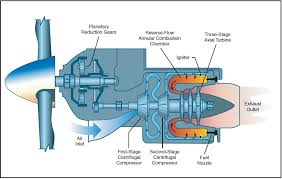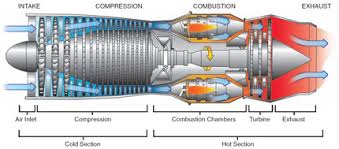How a Jet Engine Works
Jet engines make aeroplanes move forward with an enormous force,produced by a huge thrust and allow the aircraft to fly very fast.
All jet engines,also known as gas turbine,operate on the same principle. The engine draws in air from the front with a fan. A compressor increases the pressure of the air,which is made with numerous blades attached to a rotating shaft. The blades move round at high very speed,compress or squeeze the air. The compressed air is sprayed with fuel and an electric spark ignites the mixture. The burning gases expand and rush out through the nozzle,located behind the engine. As the blast of hot gases shoot backwards, the engine and the aircraft moves forward under high thrust. As the hot air is moves to the nozzle, it crosses through another group of blades known as turbine. The turbine is connected to the same shaft as the compressor. Spinning the turbine also makes the compressor to spin.
Types of Jet Engines
Turbojets The bases of a turbojet engine is easy. Air is suck through an opening in-front of the engine is compressed 3 to 12 times of its own pressure in compressor. Fuel is mixed sethe air and burned in a combustion chamber to increase the temperature of the air-fuel mixture to about 1,100°F to 1,300° F. The produced hot air is moved through a turbine,that drives the compressor.
If the turbine and compressor are very efficient, the pressure at the turbine discharge will be approximately two times atmospheric pressure, and this excess pressure is passed to the nozzle to give a high-velocity flow of gas which produces a thrust. Enormous increase in thrust is obtained by using an afterburner,which is a second combustion chamber located after the turbine and just before the nozzle.It (afterburner) raises the temperature of the gas ahead of the nozzle. The result of this increase in temperature is an increment of around 40 percent thrust during takeoff and a much higher percentage at high speeds when the plane is in the air.
The turbojet engine is a reaction engine,in wich expanding gases push against the front of the engine,gases flow through the turbine and make it spin. These exhaust gases come out of the rear of the exhaust, pushing the plane forward.
A turboprop engine is a jet engine connected to a propeller. The turbine at the rear is made to rotate by the hot gases, and this turns a shaft that drives the propeller.Similar to the turbojet, the turboprop engine is made up of a compressor, combustion chamber, and turbine, in which air and gas pressure is made to run the turbine, which then power the compressor.Unlike a turbojet engine, the turboprop has better propulsion efficiency at speeds below 500 miles per hour. Modern turboprop engines are provided with propellers that have a smaller diameter and large number of blades for efficient operation at higher flight speeds. To allow for high flight speeds, the blades are scimitar-shaped with swept-back leading edges at the blade tips. Engines having such propellers are known as prop fans.
A turbofan engine is fitted with a large fan infront, which moves in air. Most of the air flows takes place outside of the engine, making less noise and producing higher thrust at low speeds.In a turbojet all the air entering through the intake moves through the gas generator, which is made up of the compressor, combustion chamber, and turbine. In a turbofan engine a small portion of the incoming air moves into the combustion chamber. The remaining passes through a fan, or low-pressure compressor, and is passed directly as a "cold" jet or mixed with the gas-generator exhaust to produce a "hot" jet. The aim of this type of bypass system is to multiply the thrust without increasing fuel usage. It achieves this aim by multiplying the total air-mass flow and reducing the velocity with the same energy supply.
This is another type of gas-turbine engine which operates just like a turboprop engine. It does not have or drive a propeller but can provide power for a helicopter rotor. The turbo shaft engine is made in such a way that the speed of the helicopter rotor does not depend on the speed of rotation of the gas generator. This allows the speed rotor to be kept at a particular level even if the speed of the generator is adjusted to increase or decrease the amount of power produced.
The ramjet is the only simple jet engine with no moving parts. The speed of the jet "rams" or forces air through the engine. It is actually a turbojet in which rotating machinery has been removed. Its application is reduced because its compression ratio depends only on forward speed. The ramjet develops no static thrust and very little thrust in general below the speed of sound. As a result, a ramjet airplane needs a type of assisted takeoff like another aircraft. It is only used in guided-missile systems and Spacecrafts.





